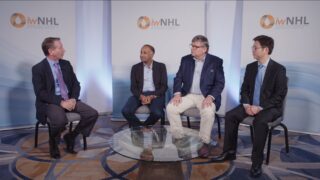We know that the bispecific antibodies targeting CD3 and CD20 are approved for treating relapsed or refractory large cell lymphoma. The two agents are epcoritamab and glofitamab. The dosing of these agents typically involves weekly ramp-up to reach the target dose. Basically, there are two weeks’ time where you go from the first to second dose and then finally reaching the target dose...
We know that the bispecific antibodies targeting CD3 and CD20 are approved for treating relapsed or refractory large cell lymphoma. The two agents are epcoritamab and glofitamab. The dosing of these agents typically involves weekly ramp-up to reach the target dose. Basically, there are two weeks’ time where you go from the first to second dose and then finally reaching the target dose. The challenge in the region, patients with relapsed refractory large cell lymphoma, sometimes the disease can be very aggressive when they are at that stage. So there is a desire to ramp up these bispecific antibodies faster to reach the target dose faster. So that’s why we did this study, and it’s a retrospective multi-center study looking at the feasibility of such a rapid ramp-up schedule of dosing in these bispecific antibodies. So we had a few centers from the United States, total 38 patients included in this study. So as we can imagine, most of these patients had unfavorable disease characteristics. For example, three quarters had primary refractory or early relapse after their first line therapy. And the patients had a median of three lines of therapy previously before the bispecific antibody. And two thirds had a prior CAR-T and 60% were primary refractory to the last line of therapy. And at the time of bispecific dosing, these patients tend to be sick and frail, and most patients had elevated LDH and bulky disease, and over one third of the patients had ECOG PS of 2 or above. So again, in these patients we attempted a rapid ramp-up, a total of 38 patients. One patient had what we call a regular ramp-up between the first and second dose, and then a fast ramp-up within just two days to the target dose. For the rest of the 37 patients, they all underwent a fast ramp-up from first dose to second dose between anywhere two to four days. And then most of the patients went on to receive a fast ramp-up to the third dose as well. A few patients kind of slowed down to five to seven days for the second ramp-up. But overall, 80% of the patients were able to reach the target dose within a week. And another 15% of the patients were able to reach the target dose within just eight to 11 days still faster than the regular dosing. So in terms of feasibility, you know, first of all, we demonstrate that it can be done. And in terms of safety, the CRS rate throughout the entire ramp-up period is about 40% occurrence and mostly grade one to two, only one grade three event and that’s short-lived. In terms of neurotoxicity or what we call ICANS, a little bit tricky, you know, two patients had a grade one or two ICANS and three grade three were reported although I have to note that at least two of those three events that were reported as grade three ICANS had an alternative explanation of the clinical presentation. One patient had a seizure which was interpreted as a grade three ICANS but on imaging he had a lymphoma progression in the brain unfortunately and another patient although again reported as grade three ICANS but it was in the setting of septic shock and altered mental status. Probably not a true grade three ICANS event, but overall in terms of ICANS and CRS rate is pretty similar to those reported in trials and the large real-world series. In terms of response rate, very close to the trial data of 50%, although the CR rate is only 20% in this high-risk sick patients. In terms of duration response, four months and median overall survival of six months with a short follow-up. So not to interpret too much from the efficacy data, but in terms of feasibility, we can get it done to reach the higher dose within a shorter time duration and with similar safety profile to the larger real-world series. We think these small-core patients really demonstrate the proof of concept and the feasibility of rapid ramp-up.
This transcript is AI-generated. While we strive for accuracy, please verify this copy with the video.















